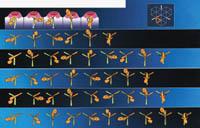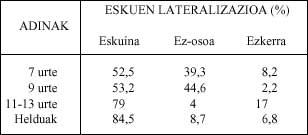Trabalenguas and Mathematics
1999/10/01 Azkune Mendia, Iñaki - Elhuyar Fundazioa Iturria: Elhuyar aldizkaria
Dressing and choosing us according to the latest fashion is something that we like almost everyone, but not everyone has the opportunity or time needed, or they have other priorities. Scientists in general have no reputation for very elegant. They don't usually waste much time in choosing and designing their wardrobe, because they have to deal with more important issues. But not all scientists think alike and two of them are the British physicists Thomas Fink and Yong Mao, who work at the Cambridge Cavendish Laboratory.

These two scientists have developed a differentiated mathematical model by which they have found eighty-one new ways to make the tie knot. It is true that most of these new forms are not usable. Many are blinded and asymmetric forms.
However, six of those eighty-one are fit for British physicists and it is little, knowing that so far people have only used four forms. The four mentioned are the single knot, the Windsor knot, the central knot of Windsor and the Pratt knot.
The latter is quite new, as it was invented in 1989. In addition, the New York Times offered him the first page. The Windsor knot is more famous. It was invented by the Duke of Windsor in 1936, when he had more time to renounce the British throne and take care of garments.
The word tie comes from the word "Croatian". In fact, XVII. In the 19th century, on the Balkan peninsula, the Croatian knights used the textile part based on a knot around the neck.
Therefore, since 1989 they have spent ten years without innovating in the knots of a fat. However, this year it has been two physicists. As Thomas Erza says, ties come to mind in a moment. The fundamental problem was the study of protein folds. It seems that this is a cider from the other cuba and that to dress elegantly has nothing to do with the knots of a crown, but its mathematical model seemed applicable to the knots of a crown. The more thought was made, the safer the formula described all types of knots.
Researcher Yong Mao is a specialist in colloids and polymers. As he has acknowledged, the relationship between these research topics and tie knots is the application of a mathematical branch called "random march". Normally used for liquids and gases and one of its founders was Mr. Pierre-Gilles de Gennes, Nobel laureate.
Physicist Thomas Fink fears that he will not add the fame of crazy researchers. Therefore, he recognizes that this work on ties is nothing more than one other fundamental studies. However, the prestigious journal Nature has published the study of tie knots.

To distinguish all the ways of making the tie knot, the two physicists mentioned schematize the tie movements in a net. All ties have a wide side and a narrow side, and the widest part is the only one that moves. It has only three paths for this: to the right, to the left or to the middle (towards the knot). Some limitations must also be taken into account. On the one hand, two consecutive movements cannot be performed on the same route. In fact, once the wide part of the tie has passed from left to right of the narrow match it cannot be repeated immediately, that is, it cannot be moved from left to right again. Each movement is inevitably different from the previous one. Also, you have to do what after the movement that touches the wide part of the tie to the shirt passes farther from the shirt and vice versa. On the other hand, the length of the tie is limited and it is not possible to make a knot of infinite number of movements. Researchers have considered a maximum of 9 movements.
With these limitations, Thomas Fink and Yong Mao have separated 85 knots, of which they have chosen the best and the most symmetrical, the most elegant. The same number of movements on the left and right have been preferred, with ten on the list. Four of these ten, of course, are already used, but none of the other six knew it. For Thomas Fink and Yong Mao, one of the most prominent is the so-called mathematically "7.2" (seven total movements and two of them toward the center).
Two physicists, after investigating the world of a fat man, have immersed themselves in "more serious" studies and at the moment have no intention of returning to the topologies of elegance. However, the application of this system to the butterfly loops of the neck allows to obtain totally interesting results, although the work is more complex. And it is that to make the loop the movements are made in two sides (and not in one as in a crown).

Gai honi buruzko eduki gehiago
Elhuyarrek garatutako teknologia




